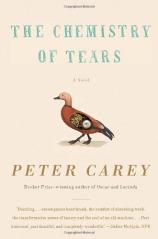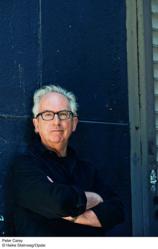The Chemistry of Tears
Review
The Chemistry of Tears
Grief is a funny thing. It can prompt anger, malaise, or renewed energy and purpose. In the case of Catherine Gehrig, grief nearly prompts self-destruction even as it demands creation. Catherine lives a mostly quiet life as a horologist (an expert in the science of measuring time), working on watches and clocks at the little-known (and completely fictional) Swinburne Museum in London. As she notes near the beginning of her story, the back offices of the maze-like Swinburne Museum are full of quiet people, creatures of habit, divided into defined specialties and spending little time together. "No one in the Swinburne knew any more than a part of the labyrinth," she notes. "We had reduced our territories to rat runs --- the routes we knew would always take us where we wanted to go. This made it an extraordinarily easy place to live a secret life."
"[A]s with Carey's other books, this one --- in its grand scope and intimate explorations --- is absolutely worth any effort it takes to decipher its inner workings."
And Catherine does lead a secret life, or at least she did until her married lover, the Head Curator of Metals, dies very suddenly. Consumed by grief, Catherine is approached by her supervisor, Eric Croft, one of the few people who knows her secret. He is also the only person who can potentially lift her out of her crippling grief, he imagines, through work.
Her assignment is to resurrect --- quite literally --- an antique automaton, a mechanical sculpture of a bird so life-like it even eats and excretes like a real duck. In her research, Catherine discovers the journals of Henry Brandling, a Victorian-era traveler on his own quest to stave off death through the artifice of mechanical creation. Henry, who is desperate to save the life of his sick young son (his daughter had died from illness earlier), travels to Germany to find someone who can execute the plans that have so captivated his child's imagination. At first drawn to Karlsruhe, a town in the Black Forest known for its cuckoo clock makers, Henry is drawn deeper and deeper into the orbit of an enigmatic figure named Sumper, who offers him hope and fear in equal measure, and into a fixation on a young boy, Carl, who may be the most skilled mechanic of them all.
As Catherine becomes more and more fixated on Henry's life, she finds herself growing more and more distant from the actual work to which she's been assigned. She grows deeply suspicious of her attractive and ambitious young assistant, and turns to vodka as often as she turns to Henry's journals to distract her mind from her pain.
Peter Carey's novels are often intricate affairs, allusive and wandering through time and place. THE CHEMISTRY OF TEARS is no exception; in fact, in its intricacy, beauty and, at times, opacity, it resembles nothing more than the mechanical beasts with which both Catherine and Henry preoccupy themselves. The themes at the heart of Carey's novel are perhaps obvious --- the human compulsion to create life, no matter how artificial, in the faith of death; the scientist's or artist's poor attempts to improve on nature --- but the ways he gets there are anything but.
The gradual merging of Catherine and Henry's stories will remind readers of A.S. Byatt's POSSESSION; the focus on automatons will remind others of Brian Selznick's HUGO. THE CHEMISTRY OF TEARS is erudite, whimsical, and more than a little frustrating at times, as Catherine's grief and Henry's mania get the better of both of them. But, as with Carey's other books, this one --- in its grand scope and intimate explorations --- is absolutely worth any effort it takes to decipher its inner workings.
Reviewed by Norah Piehl on May 25, 2012
The Chemistry of Tears
- Publication Date: February 12, 2013
- Genres: Fiction
- Paperback: 240 pages
- Publisher: Vintage
- ISBN-10: 0307476081
- ISBN-13: 9780307476081











